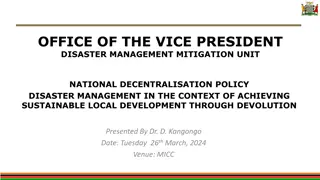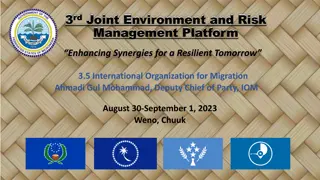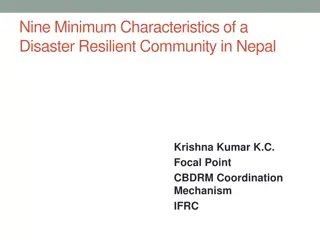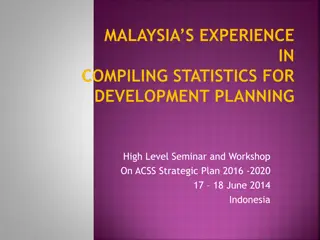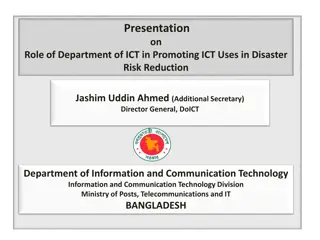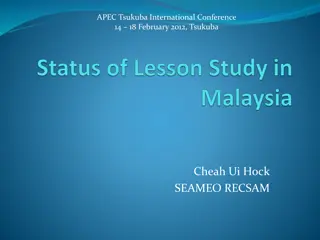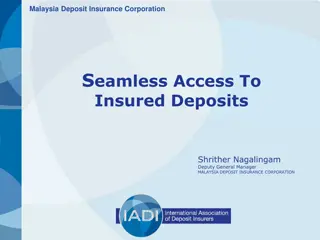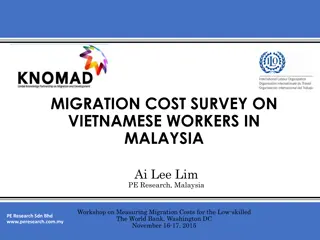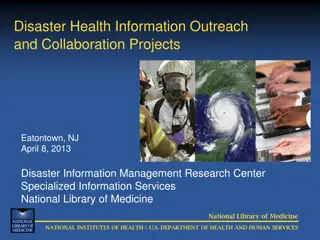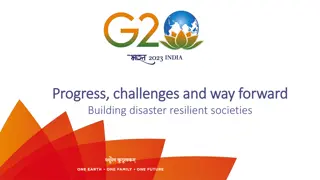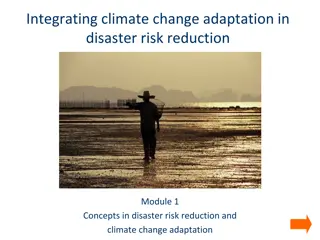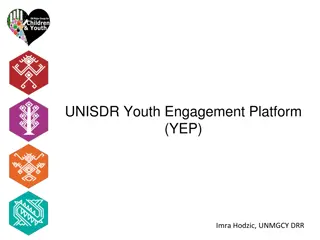Disaster Risk Reduction and Critical Infrastructure Resilience in Malaysia
International Conference on Disaster Risk Reduction 2018 highlighted the critical need to enhance infrastructure resilience in Malaysia to address challenges and damages caused by natural disasters. The Construction Industry Transformation Programme focuses on sustainable construction practices to mitigate risks and ensure the recovery of essential facilities like schools, hospitals, roads, and bridges.
- Disaster Risk Reduction
- Infrastructure Resilience
- Malaysia
- Construction Industry
- Sustainable Practices
Download Presentation

Please find below an Image/Link to download the presentation.
The content on the website is provided AS IS for your information and personal use only. It may not be sold, licensed, or shared on other websites without obtaining consent from the author. Download presentation by click this link. If you encounter any issues during the download, it is possible that the publisher has removed the file from their server.
E N D
Presentation Transcript
MOBILISE INTERNATIONAL CONFERENCE ON DISASTER RISK REDUCTION 2018 CRITICAL INFRASTRUCTURE RESILIENCE IN MALAYSIA STATUS AND CHALLENGES by Hj. Mohd Khairolden Ghani, Sr Yusrin Faiz Abd Wahab, Ahmad Farhan Roslan Construction Research Institute of Malaysia (CREAM)
Construction Industry Transformation Programme (CITP) 2016-2020 CITP under Environmental Sustainability Thrust of RMK11: Pursuing green growth for sustainability and resilience Resilience construction focus in design and project management in construction workplan guidelines ~ RM 2.9 bn damage from recent floods in the East Cost of Malaysia RM 800 mn for repair and reconstruction of schools, hospitals, roads and bridges.
Critical Infrastructure (CI) United Nations International Strategy for Disaster Reduction (UNISDR) define CI as: the primary physical structures, technical facilities and systems which are socially, economically or operationally essential to the functioning of a society or community, both in routine circumstances and in the extreme circumstances of an emergency Physical Socio-Economic Electricity and water supply, waste (water) management, transport or information and telecommunication technologies Hospitals, schools and public administration
Definition of Critical Infrastructure (CI) CI in Malaysia Context Primary physical structures, technical facilities and systems which are environmentally, socially, economically or operationally essential to the functioning of a society or community both in routine circumstances and in the extreme circumstances of an emergency. CI for Landslide i. ii. Dams iii. Buildings iv. Road v. Power and telecommunications Residential areas CI for Flood i. Insititutional/Public Facilities ii. Residential iii. Central Business District iv. Industry/Commercial Ref: CIDB (2018)
Landslide Damage in Malaysia Landslide at Lengkuk Lembah Permai, Pulau Pinang, 22 October 2017
Landslide Damage in Malaysia Landslide at Jalan Sungai Koyan Cameron Highlands, 3 February 2018 Landslide at Taman Hillview , 20 November 2002
14 Oct 2018 3 Myanmar workers buried alive Kuala Terla, Cameron Highlands
19 October 2018 , Bukit Kukus Penang
LANDSLIDE VULNERABILITY Damages on structure Records on damages value f (Landslide intensity, Str. Susceptibility) Impact of landslide on the cultural & heritage aspects f(Landslide intensity, Susceptibility cultural heritage e.g. building, monument, historical site and etc.) Physical structure Landslide event vs injury or fatalities f(Landslide intensity, Str. Susceptibility, People Susceptibility) People inside the building Cultural heritage Landslide vulnerability Wide aspect of group or community affected by landslide catastrophes f(Landslide intensity, Susceptibility of community activities) Impact of landslide on the environment aspects f(Landslide intensity, Susceptibility of environment e.g. air, water, forest and etc.) Socio- economic Environment
Flood Damage Assessment in 2014 The total repair damaged to property and infrastructure in all the affected states close to RM 1 billion 350 million ringgit to repair damaged schools in five states 200 million ringgit in property damage 100 million ringgit to repair roads in Kelantan 132 million ringgit to repair roads in Terengganu 96 million ringgit to repair 93 collapsed hillslopes along the damaged roads in four states Source: http://newsinfo.inquirer.net/662008/damage-due-to-malaysia- flood-close-to-284m#ixzz4mO1xu8AX Source: http://www.themalaymailonline.com/malaysia/article/flood- damage-estimate-tops-rm1b
2013 Flash Flood Bertam Valley Cameron
CREAM Initiatives Establishment Centre of Excellence - MAMPAN 01 02 Research activities (short term): Development of Flood Risk Assessment (FRA) and Flood Vulnerability Index (FVI) for Critical Infrastructure (CI) in Malaysia Guidelines for Landslide Vulnerability Assessment and Development of Landslide Risk Index for Critical Infrastructure (CI) in Malaysia Rating Tools Malaysian Carbon Reduction and Environmental Sustainability Tool (MyCREST) Malaysian Infrastructure Sustainable Rating Tool (InfraSTAR) 03 Seminars and Conferences 04
STI application in Policy Making Short Term Towards 2019 Guidelines to be tabled at MNKT and to be regulated by LAs Development of Flood Risk Assessment (FRA) and Flood Vulnerability Index (FVI) for Critical Infrastructure (CI) in Malaysia Quadruple Helix Approaches: Government, Industry, Academia and Community Guidelines for Landslide Vulnerability Assessment and Development of Landslide Risk Index for Critical Infrastructure (CI) in Malaysia Science-Based Policy Making for Resilient Construction [STI] Findings, Data, Model,
Development of Flood Risk Assessment (FRA) and Flood Vulnerability Index (FVI) for Critical Infrastructure (CI) in Malaysia Objectives i. To identify indicators that will be selected to construct an index for critical infrastructure in respected area. ii. To develop a multi-criteria assessment of the critical infrastructure iii. To identify the parameters for developing flood vulnerability index (FVI) of critical infrastructure and assigning score for each parameter. iv. To assist construction industry and local authorities in making decision to manage and strengthen the security and resilient of the critical infrastructure. Deliverables i. Guidelines of Flood Risk Assessment (FRA) and Flood Vulnerability Index (FVI) for Critical Infrastructures (CI) to be tabled to MNKT and regulated by local authorities
Flood 1. 2. 3. 4. 5. 6. 7. 8. 9. 10. Ir Mohd Zaki Mat Amin 11. Dr. G Balamurugan Prof. Dr. Zulkifli Yusop, FASc Prof. Dr. Hj. Ismail Abustan Dato Noor Ihsan Hj Che Mat Ir. Hj. Abdullah Isnin Ir. Hj. Shukri Muslim Dato Ir Sabri Abdul Muluk Ir. Hjh. Bibi Zarina Che Omar Zabani Md Zuki Pn Zuhaila Ahmad Zubel - - - - - - - - - - - Chairman (UTM) Deputy Chairman (USM) Committee (JKT-KPKT) Committee (JPS) Committee (JPS) Committee (JPS) Committee (NADMA) Committee (MET Malaysia) Committee (MBMB) Committee (NAHRIM) Committee (ERE Consulting)
Guidelines Assessment and Development of Landslide Risk Index for Critical Infrastructure (CI) in Malaysia for Landslide Vulnerability Objectives i. To identify issues related to vulnerability assessments and risk index for critical infrastructures. ii. To review the best practices of vulnerability assessments in other countries (Japan, Hong Kong, and Taiwan) and provide benchmarking/ comparative analysis to Malaysia. iii. To assess and develop the parameters/indicators of landslide vulnerability assessment and risk index of critical infrastructures and assigning level for each parameter. iv. To produce manual and guidelines for landslide vulnerability assessment and development of risk index. Deliverable i. Guidelines for Landslide Vulnerability Assessment and Landslide Risk Index for Critical Infratructures (CI) to be tabled to MNKT and regulated by local authorities
Landslide 1. 2. 3. 4. 5. 6. 7. 8. 9. 10. En. Nadzari Ismail 11. En. Khairudin Muhamed Ir. Dr. Che Hassandi Abdullah Prof. Dr. Roslan Zainal Abidin Prof. Ir. Dr. Ramli Nazir Dato Ir. Rohaizi Mohd Jusoh Dr. Ferdaus Ahmad Dr. Khamarrul Azahari Razak Dr. Dzul Khaimi Khailani Dr. Mastura Azmi En. Suhaimi Jamaludin - - - - - - - - - - - Chairman (JKR CREaTE) Deputy Chairman (Nilai University) Committee (UTM) Committee (NADMA) Committee (JMG) Committee (UTM) Committee (PLANMalaysia) Committee (USM) Committee (JKR) Committee (TNBR) Committee (MPAJ)
ACTIVITIES (Technical Working Group for Flood and Landslide)
Way Forward MAMPAN to be a game changer for construction industry Coordination centre for research programme on resilient in construction Open for collaboration with practitioners, scientists, authorities and associations on resilient and sustainability
THANK YOU khairolden@cidb.gov.my, yusrin@cream.my, farhan@cidb.gov.my






